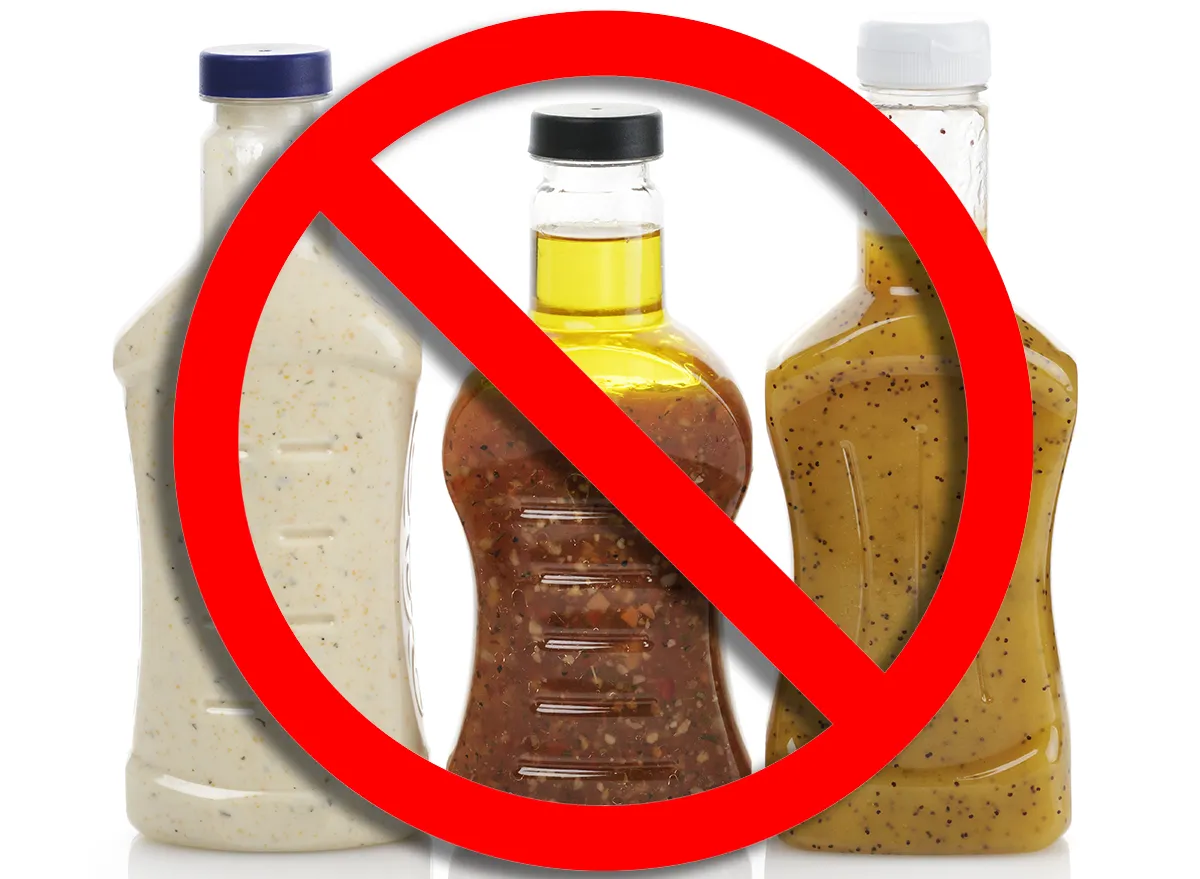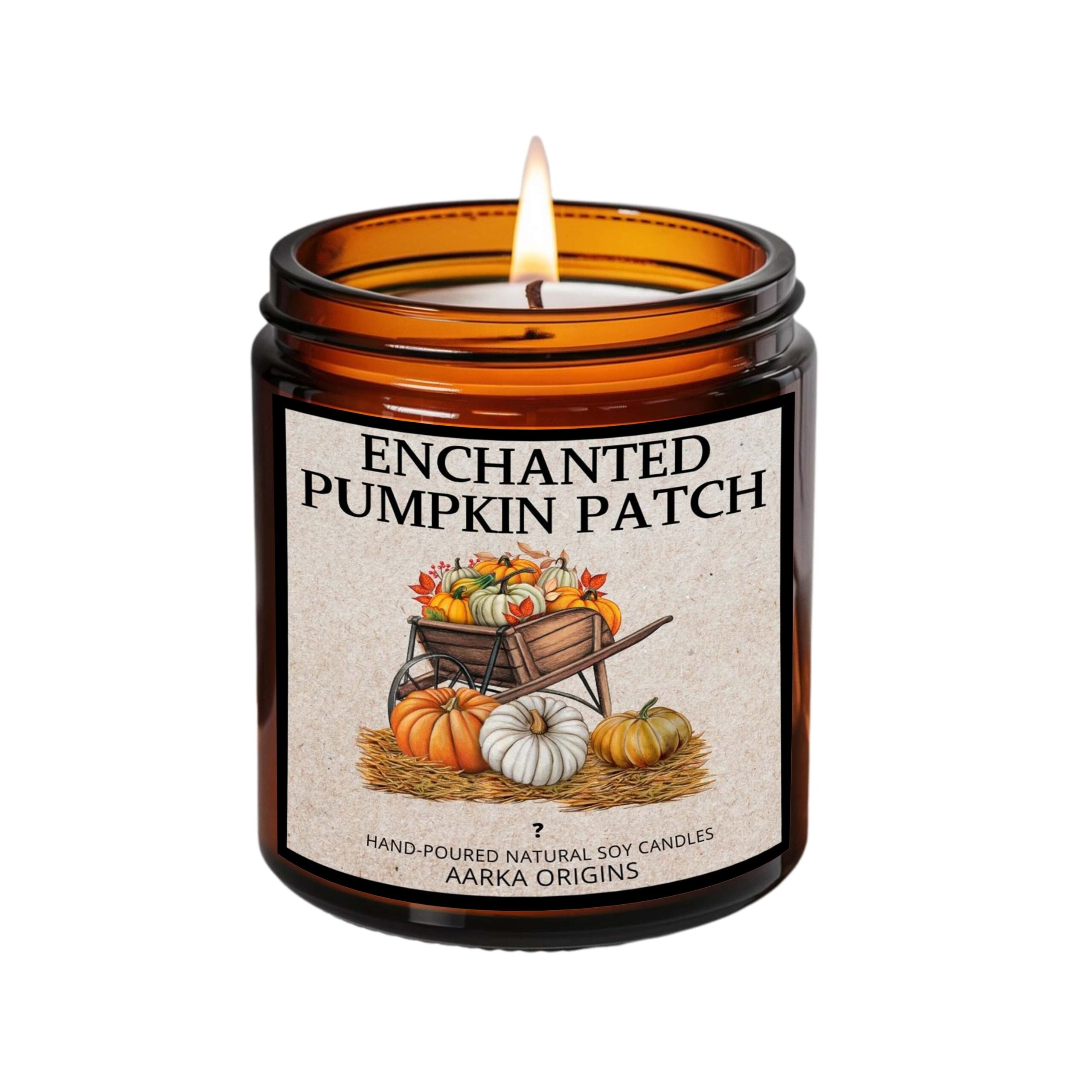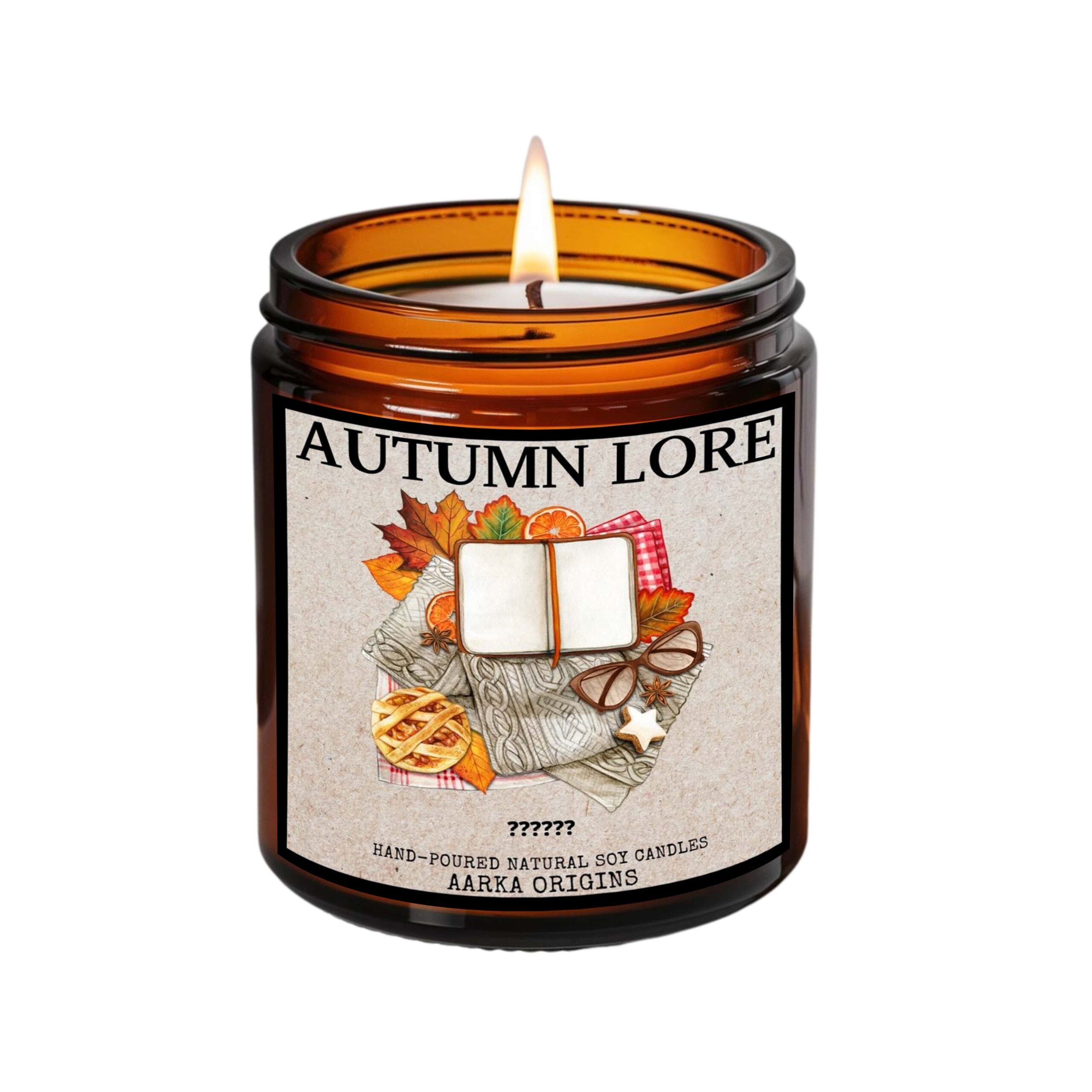Whipping up a homemade salad dressing doesn’t typically take much time, depending on what kind you’re making, but buying a store-bought one is so convenient. On busy days when you don’t have time or feel like making one from scratch, grabbing one off the shelf can make life easier, but also unhealthy.
Many are loaded with worrisome ingredients that when eaten often can impact your health.
“A lot of conventional dressings are loaded with preservatives, synthetic additives, and inflammatory oils that can disrupt gut health, drive inflammation, and work against your wellness goals — even if the product appears natural or organic, says Mary Sabat MS, RDN, LD, who is also a personal trainer.
Preservatives are added to foods like dressings to give a long shelf life and prevent food from spoiling. However, common preservatives can have potential side effects, according to Sabat.
“Sodium benzoate, when combined with vitamin C, can form benzene, a known carcinogen, she explains. “Calcium disodium EDTA, another synthetic additive used to preserve color and texture, may interfere with mineral absorption and put stress on the kidneys.”
Sabat notes that “Additives like MSG and yeast extract are often used to enhance flavor, but they’ve been linked to symptoms like headaches, brain fog, and overstimulation of the nervous system.” She adds, “Even vague terms like natural flavors can conceal dozens of chemical compounds that don’t belong in a truly clean-label product.”
But that’s not all. Thickening agents like carrageenan — derived from red seaweed — are also a concern due to their links to gastrointestinal inflammation and gut irritation.
“And while less common today, artificial colors like Red 40 or Yellow 5 are sometimes used to enhance visual appeal and have been associated with behavioral issues, allergic reactions, and other health risks,” Sabat points out. She says, “To make matters worse, many of these dressings rely on inflammatory seed oils like soybean, canola, or cottonseed oil as the base — which can further fuel systemic inflammation.”
When choosing store-bought salad dressings, the best ones are made with real ingredients that you know and recognize like avocado or olive oil, organic vinegars or citrus juice, and clean herbs and spices.
Sabat also suggests avoiding products, “with preservatives, gums, thickeners, and anything listed as flavoring.”
Now that you know what to look for in dressings, here are six to steer clear of, per Sabat.
Wish-Bone Creamy Caesar
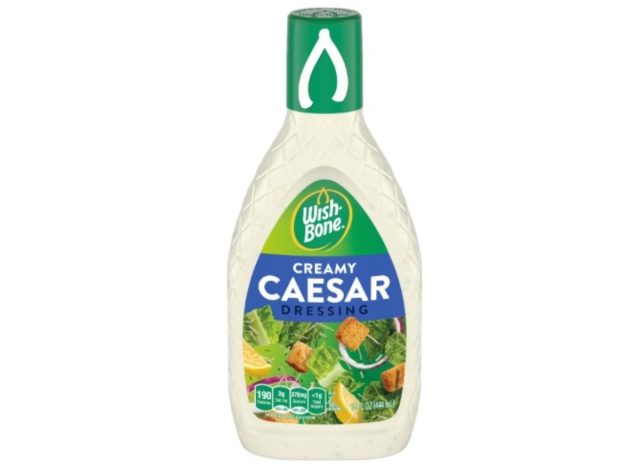
Nutrition: per serving 2 tbsp
Calories: 100
Fat: 11g (Saturated fat: 2g)
Sodium: 280mg
Carbs: 2g (Fiber: 0g , Sugar: .5g)
Protein: 0g
Ingredients: Soybean oil, water, distilled vinegar, egg yolks, sugar, Parmesan cheese (pasteurized milk, cheese culture, salt, enzymes). Contains 2% or less of: salt, anchovy paste, defatted soy flour, soy sauce (water, wheat, soybeans, salt), corn syrup, garlic*, spices, tamarind, phosphoric acid, onion*, monosodium glutamate, polysorbate 60, yeast extract, partially hydrogenated cottonseed and soybean oils, xanthan gum, natural and artificial flavors (milk), modified corn starch, mozzarella cheese (pasteurized part skim milk, cultures, salt, enzymes), whey, sodium phosphate, lactic acid, calcium disodium EDTA and sodium benzoate and sorbic acid (to protect quality).
Wishbone is a well known brand and the Creamy Caesar is no doubt tangy and flavorful, but it’s loaded with unhealthy additives and preservatives.
“This dressing contains calcium disodium EDTA, sodium benzoate, and sorbic acid—all used to extend shelf life but linked to potential health concerns,” says Sabat. “Calcium disodium EDTA can interfere with mineral absorption and burden the kidneys, while sodium benzoate, especially when paired with acidic ingredients like vinegar, can form benzene, a known carcinogen.”
She explains, “Sorbic acid, though considered less harmful, may still irritate sensitive individuals. Combined with partially hydrogenated oils (a source of trans fats), MSG (monosodium glutamate), and natural & artificial flavors, this dressing is far from clean and not a healthy addition to your salad.”
Ken’s Steakhouse Italian Dressing
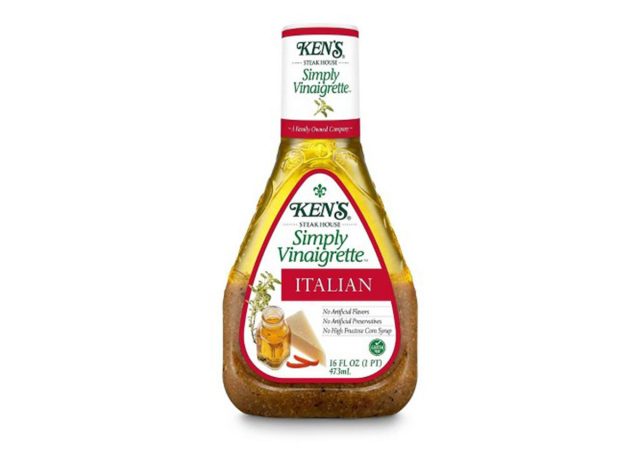

Nutrition: per serving 2 tbsp
Calories: 150
Fat: 17g (Saturated fat: 1g)
Sodium: 460mg
Carbs: 0g (Fiber: 0g , Sugar: 0g)
Protein: 0g
Ingredients: Canola Oil, Distilled Vinegar, Apple Cider Vinegar, Salt, Contains Less Than 2% of Garlic,* Monosodium Glutamate, Onion,* Polysorbate 60, Disodium Inosinate and Disodium Guanylate, Xanthan Gum, Calcium Disodium EDTA (To Protect Flavor), Beta Carotene (Color). *Dried
Ken’s Steakhouse Italian Dressing sounds like a light and healthier alternative, but according to Sabat, it’s one to steer clear of.
“It contains a few preservatives and additives that raise red flags for health-conscious consumers,” says Sabat. “The inclusion of calcium disodium EDTA is concerning, as this synthetic preservative is used to maintain flavor and shelf stability but may interfere with your body’s natural ability to absorb essential minerals like zinc and iron.”
She explains, “It also places added stress on the kidneys, especially with regular consumption.”
Another point Sabat says is important to address is the fact that the “dressing contains autolyzed yeast extract, a flavor enhancer that can be a hidden source of free glutamates (similar to MSG), which some people find trigger headaches, brain fog, or gut sensitivity.”
She says, “Paired with natural flavor—a vague term that can mask chemical additives—this dressing is far from clean and not ideal for anyone trying to reduce their intake of artificial or inflammatory ingredients.”
Kraft Classic Ranch
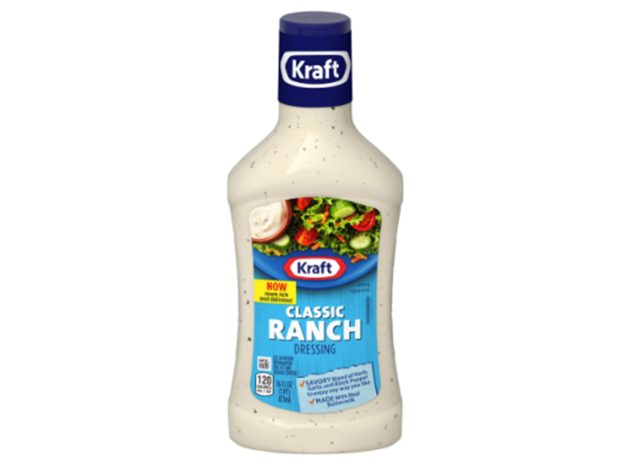

Nutrition: per serving 2 tbsp
Calories: 120
Fat: 12g (Saturated fat: 2g)
Sodium: 280 mg
Carbs: 2g (Fiber: 0g , Sugar: 1g)
Protein: 0g
Ingredients: Soybean oil, vinegar, water, buttermilk, sugar, egg yolks, contains less than 2% of: salt, onion*, monosodium glutamate, modified food starch, garlic*, whey (from milk), phosphoric acid, xanthan gum, spice, parsley*, disodium guanylate, disodium inosinate, natural flavor, potassium sorbate, sodium benzoate, and calcium disodium EDTA (to protect flavor). *Dried
Whether you love Kraft Classic Ranch as a dipping sauce or on your salad, it’s a household staple for many, but Sabat doesn’t recommend it.
“Its ingredient list reveals a host of preservatives and additives that can undermine your health,” she says. “It contains potassium sorbate, sodium benzoate, and calcium disodium EDTA—a trio of chemical preservatives used to extend shelf life and prevent spoilage.”
According to Sabat, “Potassium sorbate and sodium benzoate have both been linked to gut microbiome disruption and, in the case of sodium benzoate, potential formation of benzene, a known carcinogen, when combined with vitamin C.”
In addition, Sabat says, “Calcium disodium EDTA, another lab-made additive, may impair mineral absorption and place stress on the kidneys.”
Finally, Sabat notes that the dressing includes monosodium glutamate (MSG) and flavor enhancers like disodium guanylate and disodium inosinate, “which can trigger headaches, nausea, or sensitivity in some individuals.”
Hidden Valley Original Ranch
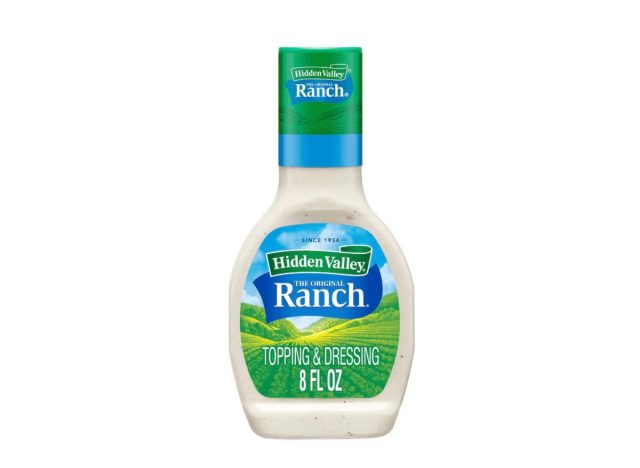

Nutrition: per serving 2 tbsp
Calories: 130
Fat: 13g (Saturated fat: 2g)
Sodium: 260mg
Carbs: 1g (Fiber: 0g , Sugar: 1g)
Protein: 0g
Ingredients: Vegetable Oil (Soybean And/Or Canola), Water, Buttermilk, Sugar, Salt, Egg Yolk, Less Than 1% Of: Spices, Garlic*, Onion*, Vinegar, Phosphoric Acid, Xanthan Gum, Modified Food Starch, Monosodium Glutamate, Natural Flavors, Disodium Phosphate, Sorbic Acid And Calcium Disodium Edta Added To Preserve Freshness, Disodium Inosinate & Guanylate, *Dried’ ‘
Hidden Valley Original Ranch is one of the most popular salad dressings. While it’s rated 4.9 on the brand’s website and is a versatile item, it is’ really unhealthy.
According to Sabat, “It’s loaded with problematic additives that make it a poor choice for anyone focused on clean eating or gut health.” She explains, “It starts with vegetable oils like soybean and canola, which are highly refined and pro-inflammatory. From there, it includes a cocktail of preservatives: sorbic acid and calcium disodium EDTA—both used to prolong shelf life but linked to mineral depletion and gut microbiome disruption.”
She says, “The presence of phosphoric acid can irritate the digestive tract and contribute to imbalanced pH levels over time. Flavor enhancers like monosodium glutamate (MSG) and the pairing of disodium inosinate and guanylate intensify taste artificially and may trigger symptoms like headaches or nausea in sensitive individuals.”
Sabat notes, “Lastly, the vague listing of natural flavors allows for hidden chemical ingredients not fully disclosed. Overall, this dressing is highly processed and far from the wholesome image it promotes.”
Kraft Balsamic Vinaigrette Dressing
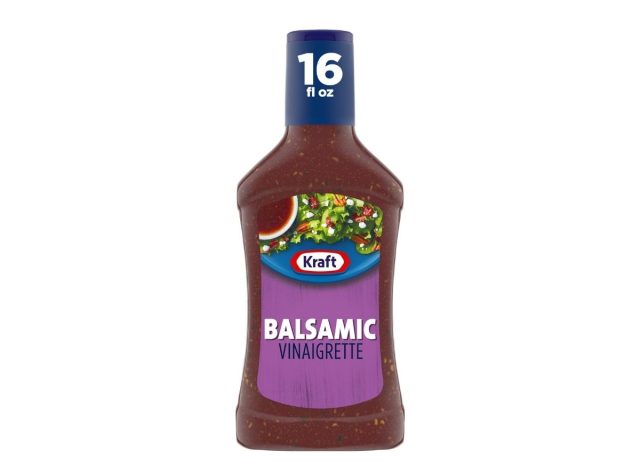

Nutrition: per serving 2 tbsp
Calories: 70
Fat: 5g (Saturated fat: .5g)
Sodium: 370mg
Carbs: 5g (Fiber: 0g , Sugar: 4g)
Protein: 0 g
Ingredients: Water, balsamic vinegar (wine vinegar, grape juice, water), soybean oil, sugar, canola oil, salt, contains less than 2% of: dried garlic, Dijon mustard (vinegar, mustard seed, water, salt, white wine, citric acid), spices, xanthan gum, oleoresin paprika (color), potassium sorbate, and calcium disodium EDTA (to protect flavor).
Kraft Balsamic Vinaigrette Dressing is another option that seems healthier, especially since it’s lower in calories, but it’s packed with alarming preservatives like potassium sorbate and calcium disodium EDTA.
According to Sabat, “Potassium sorbate is commonly used to prevent mold and yeast growth, but it can cause skin and eye irritation and has been linked to potential genotoxic effects in high amounts.”
She explains, “Calcium disodium EDTA, added to protect flavor by preventing oxidation, is a synthetic compound that may interfere with the body’s ability to absorb essential minerals like zinc, iron, and calcium.”
“While both are approved for use in food, regular consumption of products containing these preservatives adds to your overall chemical exposure,” Sabat says. “Choosing a clean-label vinaigrette made with simple ingredients like oil, vinegar, and herbs is a far better option for long-term health.”
Walden Farms Thousand Island
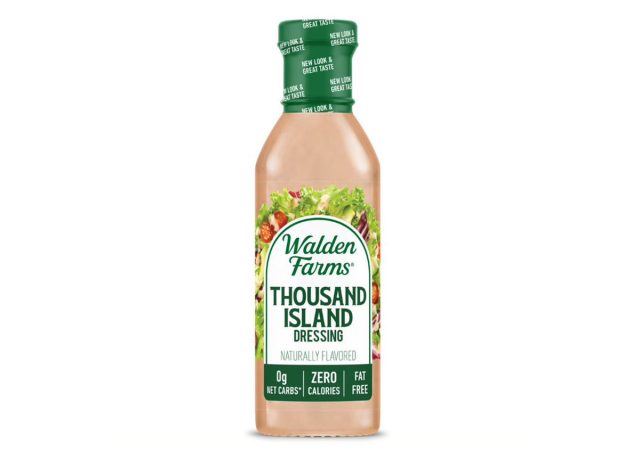

Nutrition: per serving 2 tbsp
Calories: 0
Fat: 0g (Saturated fat: g)
Sodium: 200mg
Carbs: 0g (Fiber: 0g , Sugar: 0g)
Protein: 0g
Ingredients: Water, White Distilled Vinegar, Cucumbers, Apple Cider Vinegar, Erythritol, Salt, Corn Fiber, Cellulose Gel, Tomato Paste*, Xanthan Gum, Onion Puree, Garlic Puree, Monk Fruit Juice Concentrate†, Yeast, Propylene Glycol Alginate (Algae Extract), Lemon Juice Concentrate†, Spices, Natural Flavors, Sodium Citrate, White Vinegar, Mustard Flour, Paprika, Red Bell Pepper, Turmeric, Tomato Concentrate*, Fruit and Vegetable Juice for Color*, Gluten-Free Tamari Sauce (Water, Soybeans, Salt, Alcohol), Stevia Leaf Extract, Yeast Extract, Gellan Gum, Sugar*, Dried Onion, Dried Garlic. †Adds a trivial amount of sugar. CONTAINS: Soy
With zero calories and no sugar, Walden Farms Thousand Island appears to be an ideal choice until you look at the long list of ingredients that include citric acid, sodium citrate, propylene glycol alginate, and yeast extract.
According to Sabat, “Citric acid and sodium citrate act as acidity regulators to inhibit bacterial growth and extend shelf life, but they’re often derived from GMO corn and can cause gastrointestinal irritation in sensitive individuals.”
She explains, “Propylene glycol alginate is a chemically modified emulsifier and thickener derived from propylene glycol (a compound also used in antifreeze), which can be harmful with repeated exposure.”
Meanwhile, “Yeast extract, while primarily used as a flavor enhancer, also functions as a preservative and contains glutamates similar to MSG, which some individuals may react to,” Sabat says. “Although these ingredients help maintain flavor and texture, they contribute to a highly processed product that’s best avoided in favor of dressings made with real, whole-food ingredients.”






